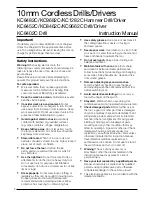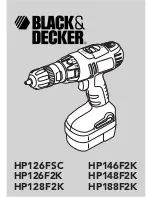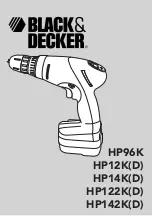
1
English
1
English
-9
1. Do not attempt to tighten drill bits (or any other accessory)
by gripping the front part of the chuck and turning the tool on.
Damage to the chuck and personal injury may result. Always lock off trigger switch
when changing accessories.
2. Be sure to tighten chuck with two hands on both the rear sleeve and the forward
sleeve for maximum tightness.
OPERATION
Always check the direction of the rotation before use.
For the drill driver:
Circling the collar are numbers ranging from 1 to 20 and a drill bit symbol. These
numbers (and part of numbers designed by dots on the collar) are used to set the clutch
to deliver a torque range. The higher number on the collars, the higher torque and
larger the fastener which can be driven. To select any of the numbers, rotate until the
desire number aligns with the selector.
The clutch feature of your Driver/Drill is an adjustable torque screwdriver mechanism
for driving and removing a wide array of fastener shapes and sizes. The clutch allows
you to instantaneously regulate the torque, based on the force applied.
Operation as a Drill:
Low voltage due to a nearly discharged battery will reduce the fastening torque
Rotate
Torque Adjustment Collar to Drill Position. Install and tighten the desired drill bit in
the hexagonal hole. Select the desired torque range to match the torque to the planned
operation, and then drill it. Follow these instructions for best results when drilling.
If the tool is operated continuously until the battery cartridge has discharged, allow the
tool to rest for 15 minutes before proceeding with a fresh battery.
Drilling:
Use sharp drill bits only. For WOOD, use twist drill bits, spade bits, power auger bits,
or hole saws. For METAL, use steel twist drill bits, or hole saws. For MASONRY,
such as brick, cement, cinder block, etc., use carbide-tipped bits. Be sure the material
to be drilled is anchored or clamped firmly. If drilling thin material, use a “back-up”
block of material so not to damage to the material. Always apply pressure in a straight
line with the bit. Uses enough pressure to keep the drill biting, but do not push too
hard or this may cause the motor to stall or defect the bit.
Hold the tool firmly to control the twisting of the drill.
IF THE DRILL STALLS, it is usually because it is being overloaded - RELEASE
THE TRIGGER IMMEDIATELY, remove drill from work, and determine the cause of
stalling. DO NOT CLICK THE TRIGGER OFF AND ON IN AN ATTEMPT TO
START A STALLED DRILL - THIS CAN DAMAGE THE DRILL.
NOTE
CAUTION











































